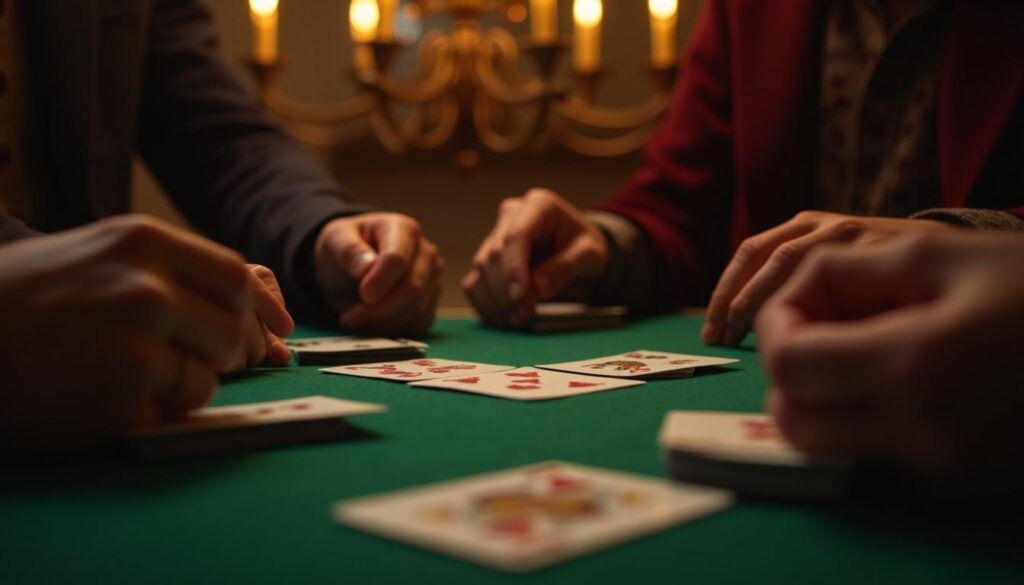Mastering Hearts Card Game Rules: A Deep Dive into Mechanics and Strategies for UK Players
Reflecting on a crisp autumn evening in 1992, when Microsoft bundled this trick-taking favourite with Windows 3.1, I remember how it quickly became a go-to distraction during university breaks here in the UK. That digital version, released in autumn that year, introduced countless players to a game with roots stretching back over a century, blending simple evasion tactics with layers of cunning that still draw crowds to online platforms today. At Spyfall, where we specialise in dissecting online card games, we’ve spent years analysing mechanics like these, from casual rounds to tournament-level strategies. In this piece, we’ll unpack the rules thoroughly, explore its evolution, and offer insights tailored for British enthusiasts who might recall it under names like Black Maria.
What Exactly Makes This Game a Timeless Classic?
This evasion-style card game stands out for its straightforward objective: avoid collecting penalty cards while forcing them onto opponents. Played with a standard 52-card deck, it typically involves four participants, though adaptations exist for three or five. The core appeal lies in its balance of luck and skill—random deals meet calculated plays, creating tension in every trick.

Originating around 1880 in the United States, as noted in historical records, it evolved from earlier European games like the Spanish Reversis from the 1600s. By the mid-19th century, specifically around 1850, key modifications emerged: hearts became the primary penalty suits, and the queen of spades gained its notorious status as a high-point card worth 13 penalties. This shift transformed it from a basic trick-taker into a strategic battle of avoidance.
In the UK, its popularity surged in the early 20th century, often played as Black Maria, where the queen of spades (or “Black Maria”) carries the same weight but with slight regional tweaks, such as varying passing rules. Tournaments aren’t as formalised as in poker circuits, but community events in places like London pubs or online UK servers highlight its enduring charm. For instance, a micro-detail: in some British circles, players traditionally sip tea between deals, adding a social ritual that enhances the relaxed yet competitive vibe.
How Do You Set Up for a Round?
Preparation is key to smooth gameplay. Begin by gathering four players and shuffling a full deck—no jokers. Deal 13 cards to each, clockwise from the dealer, who rotates after each hand. In three-player variants, remove the two of diamonds, leaving 51 cards and dealing 17 each; for five, deal 10 each and set aside two cards.
A crucial pre-play step: passing cards. Each player selects three to pass to an opponent—left in the first hand, right in the second, across in the third, and none in the fourth, cycling thereafter. This mechanic, introduced in modern rules around 2011 as per updated compendiums, allows initial hand optimisation. Before this standardisation, passing varied wildly; after, it became a fixed cycle. What it means: this evolution encourages foresight, turning a random draw into a personalised strategy session.
In UK online adaptations, platforms often automate shuffling to ensure fairness, aligning with Gambling Commission guidelines for digital games, though this one’s rarely wagered on.
What Happens in the First Trick?
The opening trick sets the tone. The player holding the two of clubs leads, a rule dating back to the game’s 1887 earliest documented guidelines. No penalty cards—hearts or the queen of spades—can be played here, preventing early disasters.
Players must follow suit if possible; otherwise, they can slough off any card, including penalties. The highest card in the led suit wins the trick, and that player leads next. A micro-detail: the two of clubs, often nicknamed the “puppy foot” in some US variants but simply “the deuce” in British play, symbolises humility in starting low.
This restriction evolved from older games like Reversis, where leads were freer. Before: unrestricted first leads could spike early scores; after: the two-of-clubs mandate levels the field. What it means: it fosters a gentle ramp-up, allowing players to gauge opponents’ hands without immediate high stakes.
How Do You Navigate Breaking Hearts?
“Breaking hearts” refers to the first play of a heart card, which can only happen after one has been discarded in a previous trick or if a player has no other option. Until then, hearts can’t be led.
This rule, solidified by the 1920s in American circles and adopted in UK play, adds psychological depth. Leading hearts prematurely is forbidden, heightening anticipation. In Black Maria, popular in Britain, this mechanic is identical, but some informal groups allow it sooner for faster games.
Strategically, we at Spyfall see this as a pivot point: hold low hearts to dump safely, or bait opponents into breaking first. Online, UK servers track this automatically, preventing rule breaches.

What Strategies Help Avoid Penalty Points?
Scoring revolves around evasion. Each heart taken in a trick adds one penalty point; the queen of spades adds 13. The game ends when someone reaches 100 points, with the lowest scorer winning—though some play to 50 for shorter sessions.
To “shoot the moon,” collect all 13 hearts and the queen, subtracting 26 from your score or adding it to others. This high-risk move, documented in variants since the 1930s, demands control over every trick.
Before shooting was formalised: games dragged with conservative play; after: it introduced bold reversals. What it means: it rewards aggression, turning potential losers into victors.
In UK contexts, where pub games favour quick wits over long grinds, passing low cards to suspected shooters disrupts plans. A micro-detail: the ace of hearts, worth just one point, often lures false security, as opponents overlook its role in moon attempts.
How Have Variations Shaped Modern Play?
Variations keep the game fresh. In Spot Hearts, hearts score face value—jack 11, queen 12, king 13, ace 14—altering risk assessment. This emerged in the 20th century for added complexity.
Black Lady, essentially the US standard since the 1920s, mirrors UK Black Maria but with fixed passing. Greek Hearts allows passing any number, fostering chaos.
Digital shifts, like Microsoft’s 1992 version (updated in Windows XP with icon changes in 2001), popularised standard rules globally. In Britain, apps rated PEGI 3 (equivalent to ESRB E for Everyone, as per 2003 ratings) make it family-friendly.
We analyse these as mechanic enhancers: variations test adaptability, much like online Spyfall modes.

What Role Does Bluffing Play in Tricks?
Bluffing underpins mid-game tactics. Feign weakness by sloughing low cards early, then strike with the queen. Timing is crucial—dump it when an opponent can’t follow suit.
In UK tournament-style play, though informal, reading facial cues (or chat patterns online) separates novices from experts. Historical changes: pre-1880, no queen penalty; post, it became a bluff centerpiece. What it means: elevates psychological warfare, akin to poker but without bets.
How Do You Handle Endgame Scoring?
Tally points per hand: sum hearts and add 13 for the queen. If moon shot succeeds, adjust accordingly. Games to 100 ensure multiple rounds, typically 5-10.
In Britain, some score to 50 for evening sessions, aligning with shorter social gatherings. Online, leaderboards track cumulative scores, with Microsoft’s 2007 Vista update adding multiplayer features until discontinued in 2012.
What Challenges Arise in Three-Player Mode?
For three players, remove the two of diamonds—dealing 17 each. Passing rotates similarly, but tricks feel tighter with one less participant.
This variant, common in UK households for odd numbers, demands sharper focus. Before removal rule: uneven deals caused disputes; after: balanced play. What it means: promotes inclusivity without diluting strategy.

How Has Digital Evolution Impacted Accessibility?
Since 1992’s Windows inclusion, digital versions exploded. Rated E for Everyone by ESRB in 1993 equivalents, it’s accessible via apps with millions of downloads.
In the UK, post-2010 mobile booms saw surges, with platforms adhering to ASA advertising standards. We at Spyfall note how AI opponents, adjustable in difficulty, mimic human unpredictability, enhancing solo practice.
What Tips Elevate Your Gameplay?
Prioritise voiding suits early to control dumps. Track the queen’s likely holder by observing spades plays. In UK online leagues, practise against varied skill levels.
Avoid leading high cards unless necessary; conserve for defence.
Frequently Asked Questions
Can You Play This Game with Betting in the UK?
While possible informally, it’s not typically a gambling game. If wagering, ensure compliance with the UK Gambling Commission regulations from 2005 onwards—though most play for fun.
What’s the Difference Between UK Black Maria and Standard Rules?
Black Maria, popular since the early 1900s in Britain, is nearly identical but sometimes omits passing or alters moon scoring to add points only to one opponent.
How Long Does a Typical Game Last?
A full match to 100 points takes 30-60 minutes, depending on players. Shorter to 50 suits quick UK pub rounds.
Is There an Official Tournament Circuit?
No formal global one, but UK card clubs host events; online platforms run daily competitions with rankings since the 2000s.
What’s the Best Way to Learn for Beginners?
Start with free apps rated PEGI 3, practising against easy AI before joining UK servers for human matches.
In wrapping up, this game remains a cornerstone of card entertainment, its mechanics refined over 140 years to blend strategy with sociability. At Spyfall, we continue exploring such titles, always keen on their online adaptations.